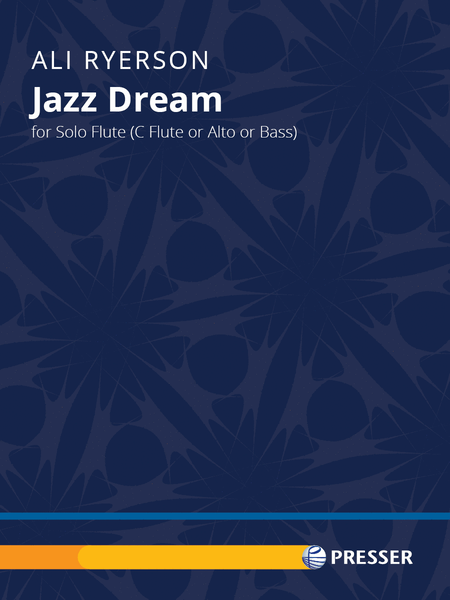Details
Description
SKU: PR.144407290
Composed by Ali Ryerson. Performance Score. 4 pages. Duration 4 minutes. Theodore Presser Company #144-40729. Published by Theodore Presser Company (PR.144407290).ISBN 9781491135150. UPC: 680160687008.
Jazz luminary Ali Ryerson traces a unique and personal artistic path in this solo work. With an engaging form reminiscent of jazz charts (a dreamy introduction, a catchy, swinging head, and improvisatory-feeling 12-bar choruses), Ryerson’s music pays deeply-felt homage to Charlie Parker and other jazz greats, while maintaining an organic connection to the lineage of unaccompanied woodwind music in the classical tradition. Classical players will gain insight into jazz harmony, rhythm, and expression as they learn this knockout recital piece, while Ryerson fans in the jazz world gain an image of her musical mind in this fully-notated composition.
Jazz Dream, a jazz-inspired solo flute piece, was commissioned by Claudia Anderson for her Glass Ceilings project. Claudia once told me that playing jazz flute has been one of her musical ambitions. I daresay her performance of JD could very well break a glass ceiling of her own!Moved by the events of 2020, composing Jazz Dream became my way of honoring my musical heroes from the Black community, namely the jazz musicians who created this music and truly broke glass ceilings. As jazz shares its origins with the blues, both genres having originated in the African-American community, I decided on a 12-bar blues form as the framework for the piece.The opening theme gently draws us into a dream-like state, with a melody in slow motion and lines that linger. When the REM cycle kicks into gear, there’s an abrupt rhythmic shift that leads straight into a swingin’ blues. Idiomatic jazz rhythms abound, with blue notes galore – the tension notes that virtually define the sound of both the blues and jazz (i.e. the flatted third, fifth, and seventh notes of a scale in place of the expected major intervals).After several groovin’ choruses of a 12-bar blues in B(, often played as if the soloist is improvising, the blues modulates to the key of E(, and as a tribute to the great Charlie Parker (AKA Bird), I harmonically suggest the more complex set of bebop changes that Parker introduced in his composition, Blues for Alice. Often referred to as Bird Changes or Bird Blues, instead of the basic I - IV – V chord progression commonly used in the blues, Parker used a series of sequential ii-V progressions (and secondary ii-V progressions). With the addition of some tritone substitutions, a chromatically descending bass line deftly replaces the original I-IV-V root movement. This is the harmonic background I was hearing as I wrote this particular chorus.After my 12-bar nod to Bird’s changes, the introductory dream theme returns, now in tempo and with a straight-ahead swing feel. Variations on this theme follow, again to be played as if improvising, with the soloist once again bringing their own personality into the performance. This section builds to a climax, the music pauses, then modulates to C, with a return to the original blues theme. The energy and groove increase through the final flourish, where a blues line ends on the idiomatic flatted fifth.

 Share
Share